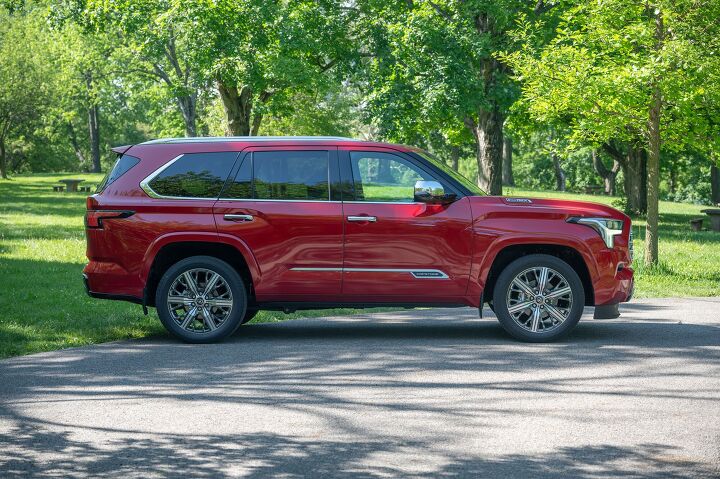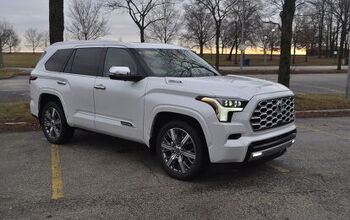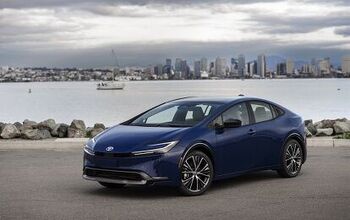2023 Toyota Sequoia Review - A Three-Row Prius?

2023 Toyota Sequoia Capstone 4WD
Toyota wasn’t the first to market a hybrid car here in the U.S. Despite that, the Prius has become the defining hybrid car of the past two decades or so, with the model name occasionally outshining the marque itself. Hybridization has metastasized throughout the Toyota lineup, punctuating nearly every model and segment with electrification.
It only stands to reason that the largest vehicles in a lineup, those vehicles for which fuel economy has never been the sole focus, should be among the last to see battery power. Within full-sized trucks and SUVs, however, there are plenty of gains to be made and plenty of room to stow extra batteries for additional economy and performance.
While the full-sized Tundra offers the choice between a standard turbo V-6 and hybridization, this 2023 Toyota Sequoia is hybrid only. How does it stack up in the real world? Is it a revelation in fuel efficiency, or does it keep you from seeing the redwood forest for the trees?
Whenever I drive a new vehicle, I try to look at it from a few angles. First, I ask myself where it might fit in my life and my driveway. But then I try and consider who the ideal buyer is, and ask how well it fits the needs of that buyer. Maybe it’s all the time I spent in sales, but I know that the marketing and planning departments always have that mythical target buyer in mind when they start to develop a new product.
Perhaps I’m a partial fit for the target demographic of the Sequoia, but I don’t specifically have a need for the size of this thing. When fitted with four-wheel drive, every trim level inches past the magical three-ton mark when empty. It’s 208.1 inches long and 79.6 inches wide, with a 122.0-inch wheelbase. I don’t tow anything regularly, but for those who do, the Sequoia can drag 8,980 pounds of boat, horse, car, or whatever.
For those who do need the capability of this big rig, it’s competitive. The 583 lb-ft of electrically-assisted torque is addictive. Sadly, dipping into the throttle does send the fuel economy reading south, as the 20 mpg combined estimate might be a bit optimistic. My time in the Sequoia yielded readings in the 17 mpg range. That’s no improvement upon what I typically experience in V8-powered domestic rivals. Maybe the big 22-inch wheels fitted to this top-level Capstone trim affect the economy somewhat, though there is no difference in the EPA ratings for lesser trims.
Comfort and ride quality aren’t what one might hope for out of a dreadnought-class SUV, either. Competitors have broadly moved to the independent rear suspension, but the Sequoia persists with the live rear axle borrowed from platform mate Tundra. Midcorner bumps send the hindquarters in a mild shimmy - it’s never uncontrollable, but it isn’t as plush a ride as one finds elsewhere.
The combination of a live axle and hybridization has another downside - rear headroom. The battery is above that axle, and thus right below the third-row seat. While this is a vehicle seemingly meant for hauling mass quantities of human cargo, those of average height and above will find themselves intimately acquainted with the texture of the headliner should they be unlucky enough to pull the short straw boarding position. Materials throughout the interior are quite nice, but that rear row is just a bit too cozy.
My concern with Toyota is they don’t seem to want to be the best with their mainstream vehicles - and that I’m talking about an eighty-thousand-dollar full-size luxury SUV as a mainstream vehicle is frankly absurd, to be honest. It feels as if Toyota is content to let their legendary customer loyalty and fabled reliability continue to feed customers into their showrooms, rather than building fully-realized market-leading vehicles. We know that Toyota has enthusiasts squirreled away within the engineering and product planning teams - witness the crazy GR Corolla I reviewed last month - but it often feels they deliberately hold back on their volume models.
The 2023 Toyota Sequoia is, frankly, more of the same. I have no doubts that they’ll easily sell every one they make. But competitors are building SUVs with fewer compromises, and that’s why I’m disappointed with Toyota’s biggest tree.
[Images: © 2023 Chris Tonn/TTAC.com]
Become a TTAC insider. Get the latest news, features, TTAC takes, and everything else that gets to the truth about cars first by subscribing to our newsletter.

Some enthusiasts say they were born with gasoline in their veins. Chris Tonn, on the other hand, had rust flakes in his eyes nearly since birth. Living in salty Ohio and being hopelessly addicted to vintage British and Japanese steel will do that to you. His work has appeared in eBay Motors, Hagerty, The Truth About Cars, Reader's Digest, AutoGuide, Family Handyman, and Jalopnik. He is a member of the Midwest Automotive Media Association, and he's currently looking for the safety glasses he just set down somewhere.
More by Chris Tonn
Latest Car Reviews
Read moreLatest Product Reviews
Read moreRecent Comments
- Redapple2 jeffbut they dont want to ... their pick up is 4th behind ford/ram, Toyota. GM has the Best engineers in the world. More truck profit than the other 3. Silverado + Sierra+ Tahoe + Yukon sales = 2x ford total @ $15,000 profit per. Tons o $ to invest in the BEST truck. No. They make crap. Garbage. Evil gm Vampire
- Rishabh Ive actually seen the one unit you mentioned, driving around in gurugram once. And thats why i got curious to know more about how many they sold. Seems like i saw the only one!
- Amy I owned this exact car from 16 until 19 (1990 to 1993) I miss this car immensely and am on the search to own it again, although it looks like my search may be in vane. It was affectionatly dubbed, " The Dragon Wagon," and hauled many a teenager around the city of Charlotte, NC. For me, it was dependable and trustworthy. I was able to do much of the maintenance myself until I was struck by lightning and a month later the battery exploded. My parents did have the entire electrical system redone and he was back to new. I hope to find one in the near future and make it my every day driver. I'm a dreamer.
- Jeff Overall I prefer the 59 GM cars to the 58s because of less chrome but I have a new appreciation of the 58 Cadillac Eldorados after reading this series. I use to not like the 58 Eldorados but I now don't mind them. Overall I prefer the 55-57s GMs over most of the 58-60s GMs. For the most part I like the 61 GMs. Chryslers I like the 57 and 58s. Fords I liked the 55 thru 57s but the 58s and 59s not as much with the exception of Mercury which I for the most part like all those. As the 60s progressed the tail fins started to go away and the amount of chrome was reduced. More understated.
- Theflyersfan Nissan could have the best auto lineup of any carmaker (they don't), but until they improve one major issue, the best cars out there won't matter. That is the dealership experience. Year after year in multiple customer service surveys from groups like JD Power and CR, Nissan frequency scrapes the bottom. Personally, I really like the never seen new Z, but after having several truly awful Nissan dealer experiences, my shadow will never darken a Nissan showroom. I'm painting with broad strokes here, but maybe it is so ingrained in their culture to try to take advantage of people who might not be savvy enough in the buying experience that they by default treat everyone like idiots and saps. All of this has to be frustrating to Nissan HQ as they are improving their lineup but their dealers drag them down.











































Comments
Join the conversation
Jumping in here to address the comments about 'the Sequoia persists with the live rear axle borrowed from platform mate Tundra'. Previous gen Sequoia actually went IRS for the 2008 MY straight through to 2022 MY.
I suspect they saw Ford go IRS in the Expedition in 2003 or 2004 and were quick to copy them. Then they saw GM stay with solid axle (and dominate the market) for another decade and decide it wasn't worth the added cost / complexity. Of course GM just went IRS, a couple of years ago, so we will have to wait another 15 year Sequoia product cycle to see if Toyota follows suit :)!
80K for a Toyota that is not named Land Cruiser...